by Eric Meier
When attempting to identify a wood sample, it’s important to keep in mind the limitations and obstacles that are present in our task. Before starting, please have a look at The Truth Behind Wood Identification to approach the task in a proper mindset; I consider the linked article to be required reading for all those visiting my site with the intent of identifying wood.
1. Confirm it is actually solid wood.
Before proceeding too much farther into the remaining steps, it’s first necessary to confirm that the material in question is actually a solid piece of wood, and not a man-made composite or piece of plastic made to imitate wood.
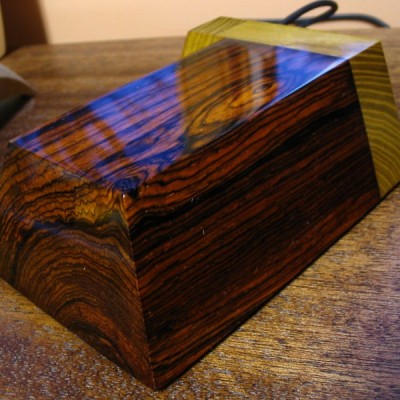
Can you see the end-grain?
Manufactured wood such as MDF, OSB, and particleboard all have a distinct look that is—in nearly all cases—easily distinguishable from the endgrain of real wood. Look for growth rings—formed by the yearly growth of a tree—which will be a dead-giveaway that the wood sample in question is a solid, genuine chunk of wood taken from a tree.
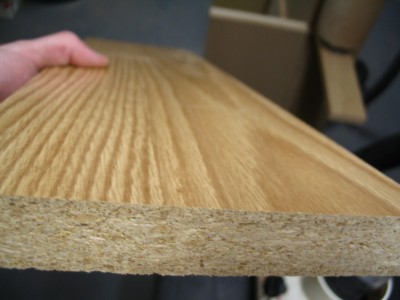
Is it veneered?
If you see a large panel that has a repeating grain pattern, it may be a veneer. In such cases, a very thin layer of real wood is peeled from a tree and attached to a substrate; sometimes the veneer can be one continuous repeating piece because it is rotary-sliced to shave off the veneer layer as the tree trunk is spun by machines. Assuming it is a real wood veneer with a distinct grain and texture—and not merely a piece of printed plastic—you may still be able to identify the outer veneer wood in question, but you should still realize that is it only a veneer and not a solid piece of wood.
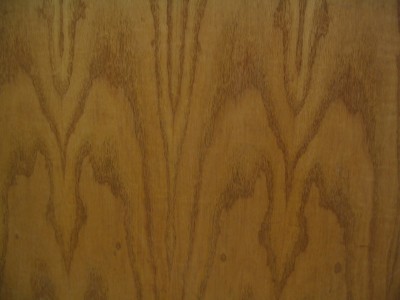
Is it painted or printed to look like wood?
Many times, especially on medium to large-sized flat panels for furniture, a piece of particleboard or MDF is either laminated with a piece of wood-colored plastic, or simply painted to look like wood grain. Many of today’s interior hardwood flooring planks are good examples of these pseudo-wood products: they are essentially a man-made material made of sawdust, glues, resins, and durable plastics.
2. Look at the color.
Some questions to immediately ask yourself:
Is the color of the wood natural, or is it stained?
If there is even a chance that the color isn’t natural, the odds are increased that the entire effort of identifying the wood will be in vain.
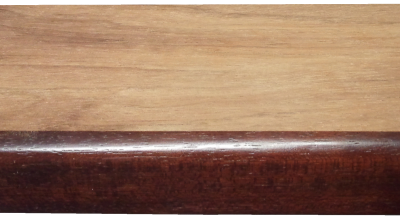
Is it weathered or have a patina?
Many woods, when left outside in the elements, tend to turn a bland gray color. Also, even interior wood also takes on a patina as it ages: some woods get darker, or redder, and some even get lighter or lose their color; but for the most part, wood tends to darken with age.
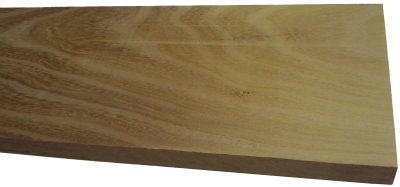
Is it possible to sand or plane the board to see the natural raw color of the wood?
The most predictable baseline to use when identifying wood is in a freshly sanded state. This eliminates the chances of a stain or natural aging skewing the color diagnosis of the wood.
3. Observe the wood grain.
If the wood is unfinished, then look at the texture of the grain. Ask yourself these questions:
Does the wood have an open, porous texture?
Most softwoods will be almost perfectly smooth with no grain indentations, while many common hardwoods have an open pore structure, such as oak or mahogany; though there are some hardwoods that are also smooth to the touch, such as maple.
Can you tell if the wood is quartersawn or plainsawn?
By observing the grain patterns, many times you can tell how the board was cut from the tree. Some wood species have dramatically different grain patterns from plainsawn to quartersawn surfaces. For instance, on their quartersawn surfaces, lacewood has large lace patterns, oak has flecks, and maple has the characteristic “butcher block” appearance.
Is there any figure or unusual characteristics, such as sapwood, curly or wild grain, burl/knots, etc.?
Some species of wood have figure that is much more common than in other species: for example, curly figure is fairly common in soft maple, and the curls are usually well-pronounced and close together. Yet when birch or cherry has a curly grain, it is more often much less pronounced, and the curls are spaced farther apart.
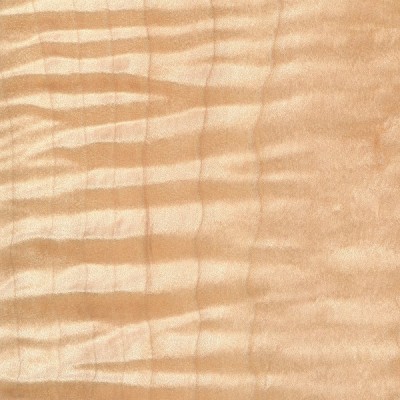
4. Consider the weight and hardness of the wood.
If it’s possible, pick the piece of wood up and get a sense of its weight, and compare it to other known wood species. Try gouging the edge with your fingernail to get a sense of its hardness. If you have a scale, you can take measurements of the length, width, and thickness of the wood, and combine them to find the density of the wood. This can be helpful to compare to other density readings found in the database. When examining the wood in question, compare it to other known wood species, and ask yourself these questions:
Is the wood dry?
Wood from freshly felled trees, or wood that has been stored in an extremely humid environment will have very high moisture contents. In some freshly sawn pieces, moisture could account for over half of the wood’s total weight! Likewise, wood that has been stored in extremely dry conditions of less than 25% relative humidity will most likely feel lighter than average.
How does the wood’s weight compare to other species?
Taking into account the size of the board, how does its weight compare to other benchmark woods? Is it heavier than oak? Is it lighter than pine? Look at the weight numbers for a few wood species that are close to yours, and get a ballpark estimate of its weight.
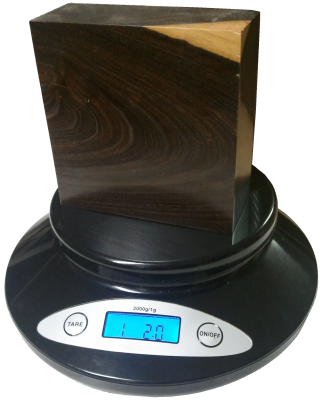
How hard is the wood?
Obviously softwoods will tend to be softer than hardwoods, but try to get a sense of how it compares to other known woods. Density and hardness are closely related, so if the wood is heavy, it will most likely be hard too. If the wood is a part of a finished item that you can’t adequately weigh, you might be able to test the hardness by gouging it in an inconspicuous area. Also, if it is used in a piece of furniture, such as a tabletop, a general idea of its hardness can be assessed by the number and depth of the gouges/dings in the piece given its age and use. A tabletop made of pine will have much deeper dents than a tabletop made of Oak. Additionally, you can always try the “fingernail test” as a rough hardness indicator: find a crisp edge of the wood, and with your fingernail try to push in as hard as you can and see if you’re able to make a dent in the wood.
5. Consider its history.
Many times we forget common sense and logic when attempting to identify wood. If you’ve got a piece of Amish furniture from Pennsylvania, chances are more likely that the wood will be made of something like black walnut or cherry, and not African wenge or jatoba. You might call it “wood profiling,” but sometimes it can pay to be a little prejudiced when it comes to wood identification. Some common-sense questions to ask yourself when trying to identify a piece of wood:
Where did it come from?
Knowing as much as you can about the source of the wood—even the smallest details—can be helpful. If the wood came from a wood pile or a lumber mill where all the pieces were from trees processed locally, then the potential species are immediately limited. If the wood came from a builder of antique furniture, or a boat-builder, or a trim carpenter: each of these occupations will tend to use certain species of woods much more often than others, making a logical guess much simpler.
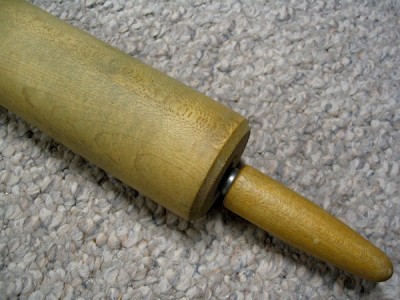
How old is it?
As with the wood’s source, its age will also help in identification purposes. Not only will it help to determine if the wood should have developed a natural patina, but it will also suggest certain species which were more prevalent at different times in history. For instance, many acoustic guitars made before the 1990s have featured Brazilian rosewood backs/sides, yet due to CITES restrictions placed upon that species, East Indian rosewood became a much more common species on newer guitars. (And this is a continuing shift as newer replacements are sought for rosewoods altogether.)
How large is the piece of wood?
Some species of trees are typically very small—some are even considered shrubs—while others get quite large. For instance, if you see a large panel or section of wood that’s entirely black, chances are it’s either painted, dyed, or stained: Gaboon ebony and related species are typically very small and very expensive.
What is the wood’s intended use?
Simply knowing what the wood was intended for—when considered in conjunction with where it came from and how old it is—can give you many clues to help identify it. In some applications, certain wood species are used much more frequently than others, so that you can make an educated guess as to the species of the wood based upon the application where it was used. For instance, in the United States: many older houses with solid hardwood floors have commonly used either red oak or hard maple; many antique furniture pieces have featured quartersawn white oak; many violins have spruce tops; many closet items used aromatic red cedar, and so forth. While it’s not a 100% guarantee, “profiling” the wood in question will help reduce the number of possible suspects, and aid in deducing the correct species.
6. Find the X-Factor.
Sometimes, after all the normal characteristics of a sample have been considered, the identity of the wood in question is still not apparent. In these instances—particularly in situations where a sample has been narrowed down to only a few possible remaining choices—it’s sometimes helpful to bring in specialized tests and other narrower means of identification.
The following techniques and recommendations don’t necessarily have a wide application in initially sorting out wood species and eliminating large swaths of wood species, but will most likely be of use only as a final step in special identification circumstances.
Odor
Believe it or not, freshly machined wood can have a very identifiable scent. When your eyes and hands can’t quite get a definitive answer, sometimes your nose can. Assuming there is no stain, finish, or preservative on or in the wood, quickly sand, saw, or otherwise machine a section of the wood in question, and take a whiff of the aroma.
Although new scents can be very difficult to express in words, many times the scent of an unknown wood may be similar to other known scents. For instance, rosewoods (Dalbergia spp.) are so named for their characteristic odor that is reminiscent of roses. Although difficult to directly communicate, with enough firsthand experience scents can become a memorable and powerful means of wood identification.
Fluorescence
While certain woods can appear basically identical to one another under normal lighting conditions, when exposed to certain wavelengths—such as those found in blacklights—the wood will absorb and emit light in a different (visible) wavelength. This phenomenon is known as fluorescence, and certain woods can be distinguished by the presence or absence of their fluorescent qualities. See the article Fluorescence: A Secret Weapon in Wood Identification for more information.
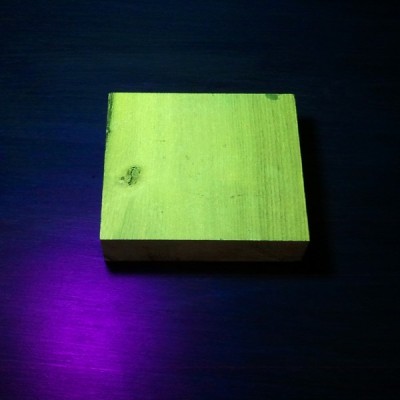
Chemical Testing
There are only a small number of chemical tests regularly used on wood, most of which are very specialized and were developed to help distinguish easily confused species with one another. They work by detecting differences in the composition of heartwood extractives. A chemical substance (called a reagent) is usually dissolved in water and applied to the wood surface: the surface is then observed for any type of chemical reaction (and accompanying color change) that may occur. Two of the most useful are the tests that are meant to separate Red and White Oak, and Red and Hard Maple.
Heartwood Extractives Leachability
Sometimes a wood species will have heartwood extractives that will be readily leachable in water and capable of conspicuously tinting a solution of water a specific color. For instance, the heartwood extractives contained in osage orange (Maclura pomifera) contain a yellowish-brown dye that is soluble in water. (This can sometimes be observed anecdotally when the wood is glued with a water-based adhesive: the glue’s squeeze-out is an unusually vibrant yellow.)
In a simple water extract color test, wood shavings are mixed with water in a vial, test tube, or other suitably small container, and the color of the water is observed after a few minutes. If the heartwood extractives are leachable by water, then a corresponding color change should quickly occur.
In addition to osage orange (Maclura pomifera), merbau (Intsia spp.), and rengas (Gluta spp. and Melanorrhoea spp.) are also noted for their readily leachable heartwood extractives. Because this property is quite uncommon, it can serve to quickly differentiate these woods from other lookalikes.
7. Look at the endgrain.
Perhaps no other technique for accurate identification of wood is as helpful and conclusive as the magnified examination of the endgrain. Frequently, it brings the identification process from a mostly intuitive, unscientific process into a predictable, repeatable, and reliable procedure.
Looking at the endgrain with a magnifier shouldn’t be a mystifying or esoteric art. In many cases, it’s nearly as simple as examining small newsprint under a magnifying glass. There are three components necessary to reap the full benefits contained in the endgrain:
I. A prepared surface.
When working with wood in most capacities, it becomes quickly apparent that endgrain surfaces are not nearly as cooperative or as easily worked as face grain surfaces. However, in this case, it is absolutely critical that a clear and refined endgrain surface is obtained.
For a quick glance of a softwood sample, a very sharp knife or razor blade can be used to take a fresh slice from the endgrain. However, in many denser species, especially in tropical hardwoods, one of the best ways to obtain a clear endgrain view is through diligent sanding. It’s usually best to begin with a relatively smooth saw cut (as from a fine-toothed miter saw blade) and proceed through the grits, starting at around 100, and working up to at least 220 or 320 grit, preferably higher for the cleanest view.
II. The right magnifier.
It need not be expensive, but whatever tool is used to view the endgrain should have adequate magnifying power. In most instances, 10x magnification is ideal, however, anything within the range of 8 to 15x magnification should be suitable for endgrain viewing. (Standard magnifying glasses are typically in the range of 2 to 4x magnification.)
These stronger magnifiers, sometimes called loupes, usually have a smaller viewing area than standard magnifying glasses. Fancier models—with built in lights, or larger viewing surfaces—are available at a premium; but the most basic models are usually only a few dollars.
III. A trained eye.
The third element that constitutes a proper endgrain examination is simply knowing what to look for. In analyzing the patterns, colors, shapes, and spacing of the various anatomical features, there is a veritable storehouse of information within the endgrain—all waiting to be unlocked. Yet, if these elements have not been pointed out and learned, the array of features will simply seem like an unintelligible jumble. The discipline of recognizing anatomical endgrain features is not easily summed up in a few sentences or even a few paragraphs, but it is nonetheless critical to the identification process. To this end, an in-depth look should be given to the various categories, divisions, and elements that constitute endgrain wood identification on the macroscopic level. (In this regard, macroscopic denotes what can be seen with a low-powered, 10x hand lens—without the aid of a microscope—rather than simply what can be seen with the naked eye.) Because the anatomy between softwoods and hardwoods is so divergent, each will be considered and examined separately:Still stumped?
If you have a mysterious piece of wood that you’d like identified, you’ve got a few options for next steps:USDA’s Forest Products Laboratory
You can mail your physical wood samples to the Center for Wood Anatomy Research.
Pros:
- Free
- Professional wood identification
Cons:
- Only available to US citizens
- Slow turnaround times (up to a month or more)
- Limited to three IDs per year
See their Wood ID Factsheet for more info.
Alden Identification Service
You can mail your physical wood samples (even small sections taken from antiques) to Alden Identification Service.
Pros:
- Professional wood identification
- Faster turnaround times (ranging from a few days to a week or two)
Cons:
- Paid service
See their ordering page for more info. (Note that Harry Alden has written several books while at USDA, including both Hardwoods and Softwoods of North America.)
Ask for help online
If the wood ID is merely a curiosity, or non-critical, you can post pictures of the wood in question.
Pros:
- Free
- No need to send physical samples
Cons:
- Greatly limited by the quality of the pictures provided
- Extra work usually required to get adequate clarity in photos
See article of Common US Hardwoods to help find the most commonly used woods.
Get the hard copy
 If you’re interested in getting all that makes The Wood Database unique distilled into a single, real-world resource, there’s the book that’s based on the website—the Amazon.com best-seller, WOOD! Identifying and Using Hundreds of Woods Worldwide. It contains many of the most popular articles found on this website, as well as hundreds of wood profiles—laid out with the same clarity and convenience of the website—packaged in a shop-friendly hardcover book.
If you’re interested in getting all that makes The Wood Database unique distilled into a single, real-world resource, there’s the book that’s based on the website—the Amazon.com best-seller, WOOD! Identifying and Using Hundreds of Woods Worldwide. It contains many of the most popular articles found on this website, as well as hundreds of wood profiles—laid out with the same clarity and convenience of the website—packaged in a shop-friendly hardcover book. 


Why I will no longer be replying to every wood ID request I’ve replied to literally thousands of wood ID requests on this site over the past 13+ years, but as the site’s popularity has grown, so has the time demands for ID on a daily basis. (Contrary to what some may seem to think, I am not some all-knowing wood wizard that can instantly ID your wood. It can actually take me a long time to sift through a lot of different resources.) Over the past few years, my backlog of pending wood species to be added to the… Read more »
Hi! I found this frame at an estate sale. It is quite heavy. Any idea about type of wood? Thank you so much and advance
Hard to make out much details in the wood grain, but in general, I would say it’s a burl wood of some sort.
Thank you so much!
Recently purchased a home, and not sure what kind of wood floors we have. The home is 111 years old.
Any idea what type of wood this furniture is? It is quite heavy. I’m trying to determine what stain colors will look like on it without buying every sample available.
Kind of hard to make out the fine details of the photos, but in general it looks like red oak, with a “golden oak” type of a stain applied.
I was thinking it’s somewhere in the oak family. Thank you so very much!
I have wood windows from 1942 that were built as WWII federal worker housing. We always assumed they were long leaf pine, but it seems a lot denser through my 10x loupe.
Trying to figure out what type of wood each of these are. First 2 are from the same bedroom set. Are any of them Elm?
Also would you have any idea if someone was allergic to elm tree, if having elm wood in the house could cause a reaction?
Thanks so much
The middle two pics seem to be a bit out of focus, but from what I can see from the first and last, it doesn’t appear to be elm. The first three appear to be veneered panels, so I’m not sure on ID. Last pic of solid wood is a diffuse porous hardwood. One possibility might be rubberwood.
Hello. I am looking to match my current hardwood floor, but have no idea what kind of wood it is. The house was built in 2003 in Colorado as a model home. The first picture is not bleached by the sun and second picture is. Thank you!
Looks like a semi-ring-porous hardwood, to me most closely matching black walnut.
Can anyone identify this type of wood? It has a fragrant smell and the dresser is altogether quite heavy and hard. Is it oak? pine?
It looks like a diffuse porous hardwood with large pores, so possibly of tropical (or at least non-temperate) origin. Neither oak nor pine. Hard to say for sure, I can’t tell if it’s been stained or if that’s the natural color.
Pictures didn’t come through. Used wenge, purple heart and unknown hardwood. Dad used to make ink pens and gave me various hardwoods. All labeled except one. White one on ends. Would like to know what type of wood it is.
I bought an old dining table recently. The top had a piece of laminate on it so I removed the laminate. We know that the laminate was not the original top. The laminate was added to it later. Under the laminate was veneer. I removed the veneer and this is what was underneath. Can anyone tell me what type of wood this is? And would anyone know about how old this table is?
I bought an old dining table recently. The top had a piece of laminate on it so I removed the laminate. Under the laminate was veneer. I removed the veneer and this is what was underneath it. Can anyone tell me what kind of wood this is? I don’t think it is letting me add a photo but it looks like different strips of wood put together most of the strips are a light color and then several throughout the table top are green.
Can anyone identify what type of wood this is? I’m guessing pine as it was near our cabin and there were many pine and aspen trees. I’m guessing pine but curious as to what type specifically. Thank you!
It looks like crepe myrtle which I have growing in my yard. It is meant to be good for furniture construction as far as I know
Would anyone be able to tell me what kind of wood this is? It’s the wood trim on our closet door, and I’m trying to figure out what it is so I can replace the missing back trim. The darkest piece is when we first uncovered it; it was obviously stained. The other pictures are after we finished paint stripping and sanding it a couple times. Is it just extremely old pine? (I know it’s at least 50 years old.)
Yes, old pine.
I just bought a house that was built in 1941 and took up the carpet to find this wood can anyone identify what kind
What type of wood is this? Thanks in advance. Brent
Just sanded the top of this coffee table down and I’m trying to figure out what type of wood it is, any helpis appreciated!
My house was built 1850 these are the original wood floors. Planks are 10″. House is in Ohio. I want to care for them appropriately, can anyone help identify the type?
Sorry I can’t tell from the photos. The wood surface looks a little rough and aged, so I can’t see the grain clearly enough.
Also curious about this desk I have … Unfortunately I did not get photos of the wood while it was raw, its does have ‘honey’ stain on it and I don’t remember if it had a distinct smell while sanding..
It’s a softwood of some sort, possibly pine.
I’ve acquired this wardrobe and I’m trying to learn as much about it as possible, including what type of wood it’s made out of..
Kind of smells like coffee when sanded..
Front and end grain photos are taken from the drawer after being sanded
TIA :)
This is my back door freshly sanded. Home was built in 1912. Design and original hardware markings indicate it is the original door. Home is in northwest Illinois.
Looks like a species of southern yellow pine.
Thanks for your help!
100+ year old dining table, had 3 extension leaves that were in horrible non-restorative shape. Has been in the family for years. Grandparents from Niagara, NY area as well as Canada. Table had very dark, maybe black, stain with several layers of urethane and furniture polish. Was easier to sand than use stripper. Stripper took forever and I still ended up sanding. Labeled photos.
Looking for some help identifying this wood that is in the living room of the house I just bought. I live in the upper peninsula of Michigan if that helps. Is it cedar? When I took a board off it smelled like cedar but it’s hard to tell as the room on the other side is done in a similar way but the boards look different.
photos were too big here is a link to a Google drive folder with the pictures.
https://drive.google.com/drive/folders/1-GIdBYcBs9s8xUWSRHumUqOBjXcLQWGU
I can’t tell from the pics, sorry. It does look like a softwood species of some sort, but for better ID, you’d really have to get a clear look at the endgrain and check for resin canals. Or, if you are very familiar with the odor of different cedars and how they differ from the scent of pine or other softwoods, you might be able to narrow it down that way, but it’s hard to describe in words. You want to get a fresh cut into the wood to make sure that it is the actual wood in question you… Read more »
Sorry, it took me 3 tries to upload a photo. :-(
Hi! I’m trying to figure out what wood my ceiling is made of. I’d like to add an accent wall to my home using the same wood and stain. Please take a look and help.
Looks like a softwood species like pine or fir.
Thanks Eric! Any chance it could be cedar? Here is a closer image.
It’s a possibility. I can’t tell conclusively from that distance, but it definitely is a softwood (cedar is a softwood).
Could someone please identify this wood? When I was cleaning out my father’s house after he passed a couple of years ago, I found several pieces just like this, all of equal size (4″x6″), finished with beveled corners. It very well may be stained, I just don’t know. He was an amateur woodworker, so that would explain why he had them, but I only took one block as a curiosity. Please don’t tell me if it is rare or valuable as the rest of the pieces are now gone forever (j/k).
It looks like an endgrain patterned piece of some sort of softwood. Basically, you take sequential slices off the same board and then rotate them and glue them together and get interesting patterns. I wouldn’t say rare or valuable, but interesting.
I’ve been trying to sand (using random orbital sa der) the painted finish off of our wooden fireplace mantle and it is taking forever. What’s mostly left now are some white paint spots and black spots I can’t identify. Can you tell from these pics what type of wood this might be? Also, any idea about the black areas?
It looks like a softwood such as pine or fir. Black areas look to just be low spots (one of them appear to be a knot) that is retaining more stain than the other areas. Should come off with a bit more sanding.
Thanks Eric!
Sorry just one more comment. By clear grain, in my comment below I mean distinctive grain. I’ve looked around at some samples and I was wondering if this was oak?
Hi all. This is a very interesting article. This chair has a clear grain I think. Located and probably made in Australia. Does anyone have any idea of what it might be made of? Thanks if you can help.
Here are four of the pics from my comment—upload didn’t work the first time.
This is a cross section I cut off the base of a chair leg from a very weathered outdoor chair. The dust from sawing/sanding is a brownish color. I sanded it and wiped it off with water, so the pictures I’m attaching include the wood when it’s wet, and also as it’s drying. (I can specify which is which if needed). There’s another picture of one of the legs after sawing, as well. Given how weathered the wood is, I can’t know if it originally had an odor. It just doesn’t now, though. Same goes for sinking in water—I don’t… Read more »
Bought this table from someone who picked it up at an estate sale and then refinished it. The seller says they were told it was from the 1960s – but then again everyone wants MCM furniture, so who knows. The table is stamped “MADE IN JAPAN” and is quite heavy – took more than a bit of effort for my partner and I to move it, though I can’t say I actually tested if it would sink in water!
Hi everyone, just trying to identify what sort of wood that is! Thanx
Hello, any idea what kind of wood this might be? The next to last pic is the underside of the table. Thank you
A bit puzzling, as the table looks like pine, though the underside shot shows oak.
Thank you for your reply, Eric!
Hi there,
Any help with identifying this type of wood ? It’s not light-weight, it’s rather solid and the legs of this table have a spot-like, line-like pattern. When sanded and unvarnished it is very light in color. It also had no significant or noticeable smell when it was sanded.
Anyone know what kind of wood this is?
It doesn’t appear to be a natural wood color, so it’s very hard to tell. The stain color is meant to imitate black walnut though. It may be something like birch.
Hello, I hope someone can help me identify the type (or types) of wood used to make this vanity. There’s a Schuster’s Milwaukee sticker inside and it had bakelite handles so I believe it would have been made sometime between 1930 – 1961 and is handmade. The wood weight varies. The drawers and doors are much heavier than the actual frame. I didn’t refinish the inside so I took photos from there. The first one is the inside of the back panel and appears to be unfinished. The rest have the original finish. The second one is the inside of… Read more »
I can’t tell exactly from the pics. It looks like at least three different woods were used. I can see a veneer of some sort for the face, and then possibly sycamore and oak for interior parts.
Thanks Eric,
I appreciate your response.
Hello, any idea what wood this would be ?
Can you reattach pics, them didn’t come through.
I just moved into a new home and want to figure out what type of wood was used on the doors, which appear to be relatively new. I’d like to use the same type of wood to build a floating beach inside. Any idea what this might be?
Looks like some very nice old growth quartersawn softwood of some sort, possibly pine. Hard to believe it’s from a new house with grain lines that tightly spaced, which are usually found in older houses with older lumber used.
Any idea what this is it is quite heavy and v.hard, was part of a pallet for something heavy but don’t know what or where ftom
Do you know what wood this is, it’s hard but quite light
Possibly oak. Hard to tell from pic.
Hi …my belief is that this is carved ironwood…am I correct?
Ironwood means different things in different regions. Do you happen to have another name for what you suspect the wood is?
Can someone ID this please? Australian made. Fairly heavy. Durable. I think it’s a hardwood.
Uncovered this hardwood flooring in a 150 plus year old structure … cannot identify . Any help is appreciated ! Thanks so much
Can you try to attach pics again? They didn’t come through.
Attaching pics again ?
Thanks, that looks like southern yellow pine.
Hello all, I need to know what kind of wood this is. Very tight grain, pretty heavy and definitely a hardwood. I apologize if the pictures don’t show enough, I can try to get a closer pic but I’ve already stained it. Any help would be appreciated, generally speaking most hardwood guitars are ash or alder, I’m just not sure what this is.
Well thanks Eric, I appreciate the input lol
2 buildings – roof beams.
Meant to add that I am trying to identify the type of wood. The buildings are from 1900s, but the roofs seem to have been updated recently.
I’m trying to figure out what type of wood this bench is. It was originally a bench in a Nashville train station and has been in the family for 40+ years. It’s heavy and I can’t make a mark with my fingernail. I’d like to remove the finish but would like to know what it’ll look like underneath first.
Can you help me with what type of flooring this is? House was built in 1967. I believe this is original flooring that has never been refinished and was under carpet for decades. It is solid wood tongue and groove 2.25” planks
It’s oak.
Got a few pieces of this from a friend who took it out of his attic when he was redoing his 1910 house. Would love to know what kind of wood this is so I can figure out the best projects for it.
Can you try to reattach pics? They didn’t come through.
Hello, this salad bowl is very heavy – 3.5 pounds, however I don’t know if it sinks in water but I believe it would. It’s 5″ high, 13.75″ in diameter. Dark (stain?) outside, light (stain?) inside. No clue where it’s from or what the wood is; I’m inquiring! Thank you in advance for information.
Pictures didn’t post on the original thread. Would like to identify. I would love to restore this beauty. I plan on placing in my kitchen and trying to figure out the best way to refinish. The door came from Louisiana the hardware dates to 1930’s. The door is heavy.
Based on location and appearance, I’d say southern yellow pine.
Hello. Can you tell me what type of wood this is. We purchased these today for our kitchen. The place where we purchased it does a lot with reclaimed wood. The original length was 10ft and at least 2” high. The owner of the reclaimed wood place gets a lot his wood from barns in upper mid west.
The boards are too rough to make out enough details for ID. Is it possible to sand a part of them a post a close up picture of the wood grain?
I am refinishing a dresser and sanded off all the (horrible) paint as finish from the drawer fronts, I am wondering what type of wood the veneer is.
The darker portions have an almost grey undertone and the middle, lighter portions have a bit of a yellow undertone, both are still a bit dusty from my sanding though.
I can’t tell from that distance, can you possibly get some closer shots of the grain? The darker portions vaguely resemble black walnut.
Thanks! I’ve sanded off the paint and finish that was on this piece, the lighter wood is very dry, the darker wood is beautifully smooth though.
Sorry, I can’t tell for sure. It’s a veneer, and it doesn’t immediately jump out to me as a common US hardwood.
Would like to identify this wood
Looks like oak, with a stain applied.